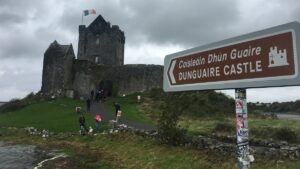The bus journey from the banks of the River Liffey in Dublin to Galway was an uneventful three hours on the motorway. Travelling from Dublin on the East Coast of Ireland to Galway on the West Coast is a trip in contrasts. Dublin is a large cosmopolitan city, whilst Galway is considerably smaller city facing the North Atlantic. Beyond the Aran Islands – it’s 3000 kilometres of deep and, at times, stormy ocean across to America.
These Gaeltacht western parts of Ireland are strongholds of the Irish Language and Galway City is a focus of promoting and supporting this ancient language. There is a theatre that only presents Irish plays. There are Irish language schools and the city even has a bilingual Irish-and-English-speaking University.
It is fitting that this westernmost Irish city should be a central point of the Wild Atlantic Way. This tourist route runs for 2500 kilometres from near the city of Derry to Kinsale near Cork. I plan to visit parts of this coastal tourist route in a few days, but right now it was time to find my accommodation.
The bus and train station are pretty much in the centre of Galway. My accommodation for the next 5 nights was only metres away. It was evening. There was time for a quick look around Galway City Centre before dark. My initial impression was of a very neat and compact city centre. The lights of a nearby eatery beckoned, but as much as I tried to make my order taste like fish, in the end I worked out it was chicken! My flight last night from Cape Town to Dublin was obviously catching up with me! Time to call it a night.
In central Eyre Square, in the sunlight of a new day, I was immediately struck by the long colourful flags hanging from flagpoles. They represented the 14 Tribes of Galway. This ‘City of Tribes’ was dominated by 14 merchant families from the 13th century to the end of the 19th. These families derived their wealth from trade with Spain and France and became very wealthy and influential. They have left their marks on the city. Lynche’s castle, for example, is a well-built, elaborate and fortified structure that now appropriately houses a local bank.
These families and the old town were protected from the local Irish and the world at large by the city walls. Today there are a few remnants of those city walls still visible. I dashed under the Spanish Arch for protection from a sudden downpour. The walled extension down to the riverside and arch protected access to the ancient medieval port on the banks of the Corrib River.
If Eyre Square is the heart of Galway, then the impressive River Corrib is its main artery. It is one of the shortest rivers in Ireland, but It drains Lough Corrib, the largest lake in Ireland, resulting in the second largest discharge of any river on the island. In the 1850’s there were mills along the banks of the Corrib using all this water, for industries ranging from flour and oats milling to distilleries and breweries. The impressive 430-year-old Bridge Mills in Galway’s ‘West End’ has been lovingly restored and is now used as a centre for languages, art and culture. Other mills have largely disappeared.
Pretty walks follow the Corrib, its tributaries and canals, as it strongly flows to enter the sea between the Port of Galway and the Claddagh.



